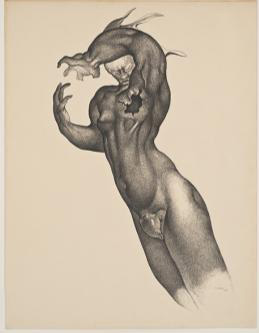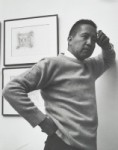
Guillermo Meza
Mexican, 1917-1997
Danza II, 1941
ink on paper
25 1/2 x 20 in.
SBMA, Gift of Mrs. MacKinley Helm
1969.35.29

Meza photographed by Lola Alvaro Bravo
Meza asserted that, "one should not just paint, one should radiate painting". He said, “It [painting] should be beautiful, never pretty, strong, clear, and savage…but never hysterical.” Meza went on to say that "painting should be definite and without clutter; above all paintings must be social, not political, and before social, human".
COMMENTS
Guillermo Meza was born of Tlaxcalan Indians in Mexico City. As a child he lived in the village of Ixtapalapa in the valley of Mexico where annually at Easter the Passion of Christ in enacted. After attending school until he was fourteen, Meza worked as an apprentice in his father’s tailor shop. Because he did not have the fifty cents each week in order to take mandolin lessons, he painted and drew in the dark rooms behind the tailor shop. In 1937 his art teacher at the Ixtapalapa night school took him to another artist as an assistant, and there he was able to paint steadily.
In Mexico City he took odd jobs to earn a living. Nevertheless, he found time to show his drawings to Diego Rivera, who sent him to Ines Amor, who sponsored Meza. Lacking the worldliness of some other artists whom Ines Amor sponsored, Meza had the simplicity, grace, and native genius of the true Indian. Though quiet almost to shyness, he alone in the group had the picturesque characteristic of the older Mexican painters. In 1940 his first one-man show was opened in the Galeria de Arte Mexicano.
Meza was a sincere artist who did not try to consciously paint the Mexican scene. Considered by many to be a true genius, he was undoubtedly the hardest working and most prolific among some of the younger painters of that time. In the first six years of his career he produced some 500 paintings and as many finished drawings. As the most widely recognized and reproduced painter of his generation, Meza passed through a stylistic evolution that carried him from complex surrealist subjects to some of great apparent simplicity.
Along with fellow Mexican modernists Augustin Lazo, Manuel Rodríquez Lozano, Roberto Montenegro, and Carlos Mérida, among others, Guillermo Meza was included in the landmark International Exhibition of Surrealism held at the Galeria de Arte Mexicano in 1940. A native Mexican, Meza recognized and explored in his painting what the European exiles and émigrés found so appealing about their new home—Mexico’s inherent “surrealism”. He naturally understood that Mexico’s rich pre-Columbian history provided an endless source of alternatives to the Western tradition of rationalism, which the Surrealists were aiming to subvert.
Transcribed from the SBMA docent council files by Ralph Wilson, and Loree Gold, 2013
SBMA CURATORIAL LABELS
The groundbreaking International Exhibition of Surrealism held at the Galería de Arte Mexicano in Mexico City in 1940 included a self-portrait by Guillermo Meza in which a section of his head is removed to reveal a hairy growth. A similar exploration of inner and outer self is seen in Danza II, which belongs to a series of ink drawings featuring lyrical figures of ambiguous sex. Meza’s knowledge of human anatomy is highlighted by his fine draftsmanship.
SBMA title card, 2013
